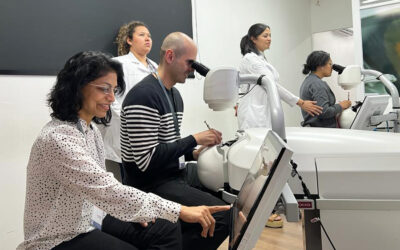Pars plana vitrectomy (PPV) is a sophisticated surgical technique used for the management of various vitreoretinal disorders by providing access to the posterior segment. Although relatively challenging to master and requiring significant technical skill and knowledge, PPV can be an indispensable tool when faced with a complication like posterior capsular rupture (PCR) during cataract surgery.
An Overview
PPV is often necessary in the presence of retinal detachment, macular hole, and complications from diabetic retinopathy. Additionally, PPV may be required during cataract surgery if the posterior capsule ruptures, leading to prolapse of the vitreous humor into the anterior chamber. This complication can obscure the surgeon’s view and complicate the procedure, potentially leading to further damage to intraocular structures if not managed promptly.
To initiate PPV, a small incision is made in the pars plana. Thereafter, the vitreous is excised, allowing access to the posterior chamber. Removing the vitreous avoids any blood or vitreous products from obstructing the visual axis, allowing assessment and repair of the retina. Balanced salt solution is infused during the procedure to maintain the vitreous space. (1)

Recognize the Signs, Take Immediate Action
In an era of exceedingly high patient expectations, cataract surgeons must be well-versed in tactical procedures such as PPV to manage PCR when it occurs. Although an infrequent occurrence, PCR requires careful evaluation and proper management. (2) The first step is to recognize the warning signs. These include sudden deepening of the anterior chamber, a visible tear in the posterior capsule, prolapse of vitreous into the anterior chamber (visualized using retroillumination techniques), and decreased red reflex due to vitreous or lens fragments obstructing the view.
Once PCR is suspected, the best course of action is to take immediate steps to stabilize PCR. This includes stopping the procedure right away to prevent further vitreous loss. Next, the anterior chamber must be stabilized. This can be achieved by injecting a dispersive viscoelastic to tamponade the vitreous. Take a moment to evaluate the extent of the tear and any vitreous prolapse. If there is significant vitreous prolapse or retained lens material, proceed with PPV to clear the vitreous and address the complications.

Knowing how to recognize and manage PCR and executing a precise PPV technique are paramount to success. A good place to practice your PPV technique is with simulation-based training. Simulation-based training offers ophthalmology trainees several compelling benefits, including the following:
- It allows trainees to practice PPV in a controlled environment, building their confidence and proficiency without the pressure of a real surgery field;
- It helps trainees learn to recognize and manage errors in preparation for real-world scenarios;
- It permits repeated practice, providing a perfect environment to master the intricate skills required for PPV such as precise instrument manipulation and effective vitreous removal;
- It can be used to replicate a wide variety of complications, offering trainees exposure to scenarios they might not frequently encounter; and
- It offers immediate feedback on trainee performance.
In the summer of 2024, HelpMeSee is launching a PPV course designed to help ophthalmology trainees master the skills needed to manage PCR effectively. It will cover five main areas, which are viscoelastic-assisted nuclear fragment removal, trocar and cannula insertion, vitrectomy, cortex removal, and IOL placement in the sulcus and trocar removal. By completing the program, trainees will understand how to prevent nuclear fragments from dropping into the vitreous, achieve correct angulation for a self-sealing wound, ensure no residual vitreous remains, avoid triggering more vitreous prolapse, and place a three-piece foldable IOL properly while removing the trocar safely.

Conclusion
Mastering PPV is a critical skill for ophthalmology trainees. A comprehensive simulation-based training program such as the HelpMeSee course Posterior Capsular Rupture Management with automated vitrectomy using a pars plana approach offers an effective, risk-free way to learn the essential steps of PPV and develop the necessary skills to manage PCR effectively. Ultimately, precise and effective management leads to optimized outcomes and better quality of life for patients.
Learn More About Training in Your Region
Instructor-led Simulation-based Training Courses
Learn More About Training in Your Region
Instructor-led Simulation-based Training Courses
Learn More About Training in Your Region
Instructor-led Simulation-based Training Courses
HELPMESEE SPONSOR’S








- Omari A, Mahmoud TH. Vitrectomy. StatPearls [Internet]. Accessed July 25, 2024. https://www.ncbi.nlm.nih.gov/books/NBK551668/
- Waghamare SR, Prasad S, Sankarananthan R, et al. Nucleus drop following phacoemulsification surgery: incidence, risk factors, and clinical outcomes. Int Ophthalmol. 2024;44(1):247.
RECENT NEWS
Women in Ophthalmology: Overcoming Obstacles and Embracing Technology
Significant strides have been made to increase the representation of women in medicine. In ophthalmology, specifically, the journey toward gender equity...
Objective Feedback Maximizes Learning in VR Eye Surgery Training
Feedback is a crucial component of cataract surgery training programs. It enables trainees to learn from experienced surgeons how to refine their skills...
Simulation-based Learning Is Driving Success in Ophthalmic Training
Cataract surgery is an intricate procedure that requires years of training and skills acquisition. Although traditional training methods such as...




